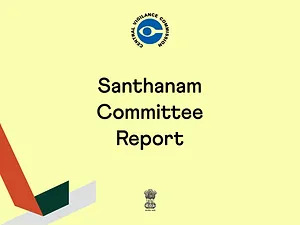SANTHANAM COMMITTEE REPORT

The Santhanam Committee Report holds significant importance in the history of the CVC in India. This report, named after its chairman, Shri K. Santhanam, was pivotal in shaping the establishment and functioning of the CVC. The Report provided exhaustive insights into the prevalence of corruption, its causes, and the measures required to combat this social problem. The committee conducted a comprehensive analysis of corruption in various sectors, including government agencies, public sector businesses, and the judiciary.
The report's corruption definition was one of its most important aspects. It defined corruption as "behaviour by officials in the public sector, whether politicians or civil servants, in which they improperly and illegally enrich themselves or those close to them, or induce others to do so by misusing their position." This definition provided the groundwork for comprehending and recognising corrupt practises in a variety of domains. In addition, the report emphasised the significance of preventive measures in combating corruption. It suggested the establishment of a vigilant and transparent system in which corruption is actively discouraged and quickly detected.
The committee proposed establishing a Central Vigilance Commission (CVC) as the apex body charged with preventing corruption and promoting integrity in public administration. In addition, the Santhanam Committee emphasised the need for a robust and impartial anti-corruption agency. It was suggested that the CVC be granted the authority to conduct investigations, investigate complaints, and impose sanctions against fraudulent officials. The committee emphasised the significance of safeguarding whistleblowers and providing them with adequate protections in order to encourage the reporting of corrupt practises without fear of retaliation. In addition, the report recommended the development of a code of conduct for public servants that would outline the expected ethical standards and professional conduct. It emphasised the significance of training and educating public officials about ethical values and the repercussions of corruption.
Systemic reforms were emphasised in the Santhanam Committee Report, which was another significant aspect. To reduce discretion and opportunities for misconduct, the committee suggested streamlining administrative procedures, simplifying rules and regulations, and implementing technology-driven solutions. It emphasised the importance of accountability and openness in public procurement, financial administration, and decision-making processes.The Santhanam Committee Report had a significant impact on the CVC's operations and India's overarching anti-corruption efforts. The report's recommendations paved the way for the establishment of the CVC in 1964, which was charged with preventing corruption and promoting integrity in public administration.
The report's findings and recommendations continue to impact India's anti-corruption efforts. Over time, subsequent committees and commissions have built upon the work of the Santhanam Committee, resulting in the evolution of the country's anti-corruption framework.In conclusion, the Santhanam Committee Report played a vital role in India's fight against corruption. Its comprehensive analysis, recommendations, and emphasis on preventive measures have shaped the Central Vigilance Commission's operations and had a lasting impact on the country's struggle against corruption.






